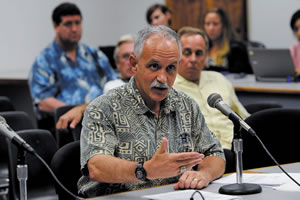Apple’s Dire Warning Has Merit
The University of Hawaii has an identity problem. Regardless of the strides made in research and the increased enrollment of Native Hawaiians into the system, the state’s flagship university is seen as a quagmire of self-interest and financial incompetence.After decades of questionable decision-making, it’s an assessment not without merit.
Let’s be honest, UH is a dump.
It’s underfunded, poorly maintained, getting more expensive and seemingly stricken by one scandal after another.
A quick list includes the Pacific Ocean Science and Technology Center, which was years behind schedule and not usable upon completion; the Rainbow Wahine Softball Stadium, built without sight lines of home plate; Herman Frazier; Evan Dobelle; Stevie Wonder … it goes on and on.
Now the athletic department faces an estimated $13 million deficit (through fiscal year 2014), disgruntled fans, an exodus of boosters (both voluntary and otherwise), disappointing on-field performance and a number of expiring coaches’ contracts.
This is the mess in which UH chancellor Tom Apple must operate, and find a solution.
Apple, whether fair or not, has the job approval rating of Congress.
He brought further negative attention on himself and UH when he revealed to Ka Leo O Hawaii editor Marc Arakaki that should the department not find a solution to its funding problem in three years, he would consider moving the state’s only Division I athletic program down to D-II.
It was an admission met with widespread condemnation in an outpouring of misdirected anger.
Apple’s call to arms is not without precedent. Months ago, Big Ten commissioner Jim Delany described a similar situation should the Ed O’Bannon lawsuit – which seeks payment for the use of a college athlete’s image and likeness in video games and other revenue-generating products – be successful.
The Big Ten, with its massive TV contracts, could likely withstand most financial threats, but for smaller schools in lesser conferences, like UH, a reassessment of the schools’ financial future and competitive aspirations is inevitable.
It came as no surprise when USA Today recently reported that just 23 of 228 public university athletic departments in 2012 generated enough income to cover expenses. Of those lucky 23, 16 received some form of subsidy, with 10 getting an increase in financial assistance from 2011 to 2012.
That college sports is an economic sinkhole has been well established, even for those with seemingly endless streams of income.
Penn State, No. 8 in the nation with more than $108 million in total revenue, generated a profit of only $863,023.
This amounts to a return on investment of less than 1 percent. Accounting for inflation, the Pennsylvania school lost an approximate 2 percent of its buying power from the year before.
UH is no Penn State, and with the added burden of mediocre conference affiliations and high travel costs, it was inevitable under the current system that UH would come up short.
Unlike many of the larger schools stuck in an endless loop of bidding wars and the ever-expanding outlays for athletic accoutrements, UH’s problems are for the most part repairable.
A simple turnover of funds from event parking, logo wear sales, food concessions and a more favorable Aloha Stadium use arrangement would go a long way to eliminate the annual deficits.
The one thing the university cannot do is forgive the debt owed by the department.
According to the Wall Street Journal, undergraduate tuition at UH since 2006 has grown 108 percent – second most in the country over the period.
To wipe out such debt while increasing tuition and pushing the maintenance backlog toward $500 million would be an insult to students not athletic enough to get a free education, while sending the wrong signal about the university’s priorities.
Apple would have been best served by channeling political debate and speak for 20 minutes without saying anything. That he didn’t suggests either a lack of preparation or a shocking moment of honesty at a university in critical need of open dialogue.
Let’s hope for the latter. The future of UH athletics, in the short term, rests in Apple’s hands. He’s in charge of the Manoa campus, including athletics.
If he can work with university leaders and state legislators to create a more equitable split of revenue, the department should be able to operate in a financially sound manner.
If not, the next conversation may not be in dropping to D-II but dropping athletics altogether.
No university can continually operate in the red and stay in business.




